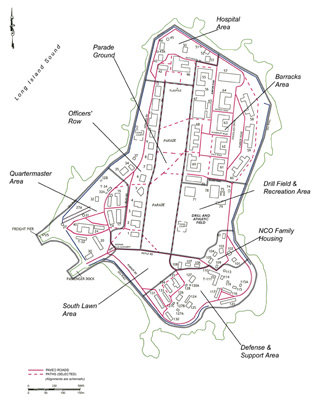|
Fort Slocum’s Functional Areas |
|
Fort Slocum was organized geographically into functional areas. Each area was a small neighborhood in which particular activities dominated. The functional areas provide a convenient way to understand the geography of Fort Slocum as it was, before nature, vandals and demolition crews permanently changed the landscape.

Nine Functional Areas
In the last few decades that Fort Slocum was an active post, there were nine functional areas. The Parade Ground was at the center, and the eight other areas were arranged around it. Clockwise from the southwest the areas surrounding the Parade Ground were:
The entrance to Fort Slocum was on the southwest in the Quartermaster Area. Officers lived on the western side of the island, primarily on Officers’ Row. Most enlisted personnel lived on the opposite side, generally in the Barracks and NCO Family Housing areas.
The buildings of the post’s hospital dominated the northern end of the island, and the large earthwork of the coastal mortar battery, with a mixed group of buildings adjoining it, occupied the southeast. The Drill and Recreation Area filled the open space to the east of the Parade Ground, while the South Lawn Area covered the southern end of the island.
Roads or walkways marked many of the boundaries between the areas. Terrain features such as slopes or leveled ground also served as boundaries.
Analytical and Historical Geography
The Army deliberately arranged Fort Slocum into sections with groups of functionally-related buildings. These groupings were typical of U.S. Army posts built in the late 19th and early 20th centuries, as Fort Slocum was.
Because activities in some areas and the functions of many buildings changed over time, the nine areas reflect a contemporary historian’s analysis of Fort Slocum’s layout. They are probably closest to the actual functional layout of the post around 1940, on the eve of the Second World War. Still, they may not describe the post’s layout exactly as a soldier of that era would have.
|




 Functional Areas
Functional Areas